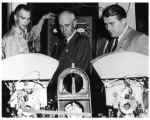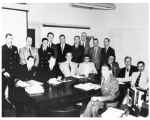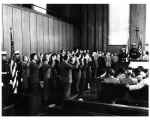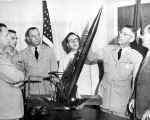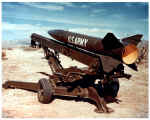1953 - 1955
|
January to June 53 During this period, another 15 DA Special Employees (i.e., German scientists) were added to the arsenal's personnel rolls. 16 January 53 The organization charged with the development of the REDSTONE missile, the Guided Missiles Development Branch of the Technical & Engineering Division (formerly the Ordnance Guided Missile Center) was redesignated the Guided Missile Development Division of OML. Dr. Wernher von Braun was appointed chief of the division. February 53 The responsibility for issuing contracts to " Paperclip " personnel (DA Special Employees) was assigned to the Purchasing and Contracting Division. This change was implemented after the majority of personnel in this category were converted to Civil Service status. February 53 The Chief of Ordnance transferred responsibility for technical supervision of an improved version of the NIKE I (AJAX) to Redstone Arsenal. The new antiaircraft missile was called the NIKE B. 3 February 53 Soliders fired their first CORPORAL missile. |
|
9 March 53 The Troop Command, formerly assigned to the Ordnance Guided Missile School, became a service agency of Redstone Arsenal with the same title. |
|
18 May 53 Three men were injured at a Thiokol facility on Redstone Arsenal when a rocket was prematurely ignited. 8 June 53 The first 24 college students to be employed by Redstone Arsenal during the summer reported for work. Assigned to OML, the students were juniors and above, majoring in science. |
|
27 July 53 United Nations and North Korean officials signed an armistice halting the Korean War. Following the cease fire, the Army's need for ammunition decreased, resulting in a change in priority on all scheduled items being manufactured at Redstone Arsenal by the Ordnance Ammunition Center. 27 July 53 The first REDSTONE production missile was delivered. 12 August 53 The Chief of Ordnance charged Redstone Arsenal with research and development of liquid propellants, except petroleum fuels, liquid oxygen, and other industrial gases. 20 August 53 The first REDSTONE R&D missile was flight tested. 1 September 53 The basic (M31) HONEST JOHN was type classified "substitute standard" pending the completion of service tests. This action also allowed the release of the final R&D tactical prototype drawings and specifications for the procurement of 1,800 rounds. The product improvement and industrial programs began with the M31 classification. 15 September 53 Redstone Arsenal experienced a serious accident when a rocket being handled by two men on Thiokol Corporation's Line 1 exploded. The initial blast triggered two other explosions in the small extrusion press bay where a total of four men were working. All four employees died as a result of injuries sustained in the blast. November 53 The OCO transferred technical supervisory responsibility for the Boosted Rocket Tank Weapon from Picatinny Arsenal to Redstone Arsenal. Feasibility studies of this system had begun in 1953. After further studies by the contractor and the Ballistics Research Laboratories (BRL), Redstone and BRL presented their weapon design to a Technical Assessment Group on 18 August 55. The contractor began development in October 55. This program was transferred to ARGMA's jurisdiction as of 1 April 58. |
|
December 53 The NIKE I became operational during this month. 7 December 53 Redstone Arsenal was designated as the mission arsenal for industrial activities pertaining to remotely controlled aerial targets and associated ground guidance equipment. 1954 The M31 HONEST JOHN, the first U.S. tactical nuclear weapon, was deployed in the spring of this year as an interim system. 1954 Late in the year, an agreement was reached between the United States and the United Kingdom (UK) in which the United States agreed to furnish the UK with 113 Type II CORPORAL missiles and associated ground equipment. These were the first U.S. guided missiles destined for service in a foreign country and used by a foreign power. January 54 Douglas Aircraft Company delivered the first production basic HONEST JOHN system. 11 January 54 Ordnance delegated technical supervision of the LACROSSE project to Redstone Arsenal. The program had begun in 1947 with Marine Corps requirements for a guided missile to supplement conventional artillery in close support of ground troops. Project LACROSSE was established at the Applied Physics Laboratory (APL) of John Hopkins University. The Cornell Aeronautical Laboratory, Inc., studied guidance accuracy for the system. All were under contract to the Navy Bureau of Ordnance. 24 January 54 Redstone Arsenal experienced its eighteenth devastating flood. On this date, the water level reached a high of 566.6 feet above sea level, only 1.2 feet below the all-time high recorded in January 46. |
|
20 March 54 The first NIKE I battalion was tactically deployed on this date. April 54 The Ordnance Ammunition Command (OAC) assigned the Ammunition Division a special project preparing manufacturing descriptions on certain ammunition items processed at Redstone Arsenal. The project's primary objective was to produce documents describing the manufacturing methods and equipment in such detail that a manufacturer could establish a loading, assembly, and packing ammunition plan in the shortest possible time and at minimum expense. April to May 54 During Operation Flashburn, held at Fort Bragg, North Carolina, under the jurisdiction of the Headquarters, Third Army, ground troops used the HONEST JOHN and the CORPORAL for the first time in a large-scale atomic field training maneuver. 15 May 54 The NIKE missile was placed on public display for the first time in this area on Armed Forces Day. June 54 The first eight batteries of the Basic H3l HONEST JOHN rocket system were fully equipped during this month. June 54 The Commander, Patrick Air Force Base (AFB), Florida, authorized limited use of the Grand Bahama Island impact area for the REDSTONE test missiles. July 54 The CORPORAL I missile system was first issued to Army troops. July 54 The first LOKI rocket firing tests were conducted during this month. 1 July 54 Responsibility for the technical control and supervision of the T225 High Explosive Anti-aircraft Rocket was transferred to Redstone Arsenal effective this date. This rocket was to be used as an effective air-to-air weapon against fighter planes. August 54 Pickets were posted at Redstone Arsenal gates when Teamsters Local Union #402 went on strike to protest the hiring of non-union truckers by their employer, an arsenal construction contractor. In support of the Teamsters, employees from four other arsenal construction contractors walked off their jobs. This strike involved 298 employees and delayed construction work at the arsenal for about 1 week. August 54 Redstone Arsenal was reconfirmed as a permanent DA installation. September 54 The M31Al HONEST JOHN rocket was type classified standard, and the M31 rocket was redesignated as limited standard. 1 September 54 BG Holger N. Toftoy assumed command of Redstone Arsenal effective this date, after BG Thomas K. Vincent, retired from the Army on 31 August 54. |
|
20 October 54 Redstone Arsenal was delegated responsibility for technical supervision of the PLATO project, the groundwork for which had been laid in May 51 when the Ordnance Corps formally established long-range military characteristics for a guided antimissile missile. Studies of this system were conducted by Sylvania Electric Products, Inc., (April 53) and the Cornell Aeronautical Laboratory, Inc. (May 54). |
|
1955 Redstone Arsenal and Douglas Aircraft Company officially began work on the HONEST JOHN Improvement Program. The arsenal's Ordnance Missile Laboratories served as the prime contractor equivalent and exercised technical supervision and control of the overall project, with Douglas Aircraft serving as subcontractor. Responsibility for this project was given to ARGMA on 1 April 58. January to June 55 The OCO notified Redstone Arsenal that the Public Housing Administration would dispose of the Redstone Park housing project unless the arsenal agreed to take it over. The arsenal agreed to accept responsibility for the operation and maintenance of the housing project if sufficient funds for rehabilitation were provided. |
|
13 January 55 The first NIKE B missile was launched. February 55 The 259th Field Artillery Missile Battalion (CORPORAL) became the first U.S. ballistic missile unit to be deployed overseas. 3 February 55 The Army Chief of Ordnance sent a memorandum to the DA Chief of Research and Development proposing that the Department of the Army offer the services of Redstone Arsenal's Guided Missile Development Division to the Air Force for the development of a 1,000-nautical mile "tactical" missile. Although the Secretary of the Army approved this proposal, the Air Force did not accept the offer. March 55 Research on the third member of the NIKE family, the NIKE II, began under the technical supervision of Redstone Arsenal. 1 April 55 The Glenn L. Martin Company was awarded a co-contract for research and development of the LACROSSE missile system. |
|
20 April 55 The launching of REDSTONE Missile RS-9 at 0151 hours marked the first scheduled night firing of a REDSTONE missile. 16 May 55 The American Federation of Labor (AFL) Electricians Local began picketing at the Redstone Arsenal gates in an attempt to organize a small group of non-union electricians employed by one of the arsenal's construction contractors. The company tried to proceed with its work, but unionized construction workers (beginning with electricians on 16 May and extending to the bulk of workers the next day) refused to cross the picket lines. The ensuing work stoppage affected about 16 contracts held by seven different companies involved in the construction of various facilities for OML and OGMS. About 700 construction workers, representing all the trades, stopped work thereby halting about 90 percent of the arsenal's construction activity. The Corps of Engineers, acting in its capacity as contract, sent representatives to meet with local union officials and representatives of the electrical contractor. As a result of meetings held between 23 and 25 May, the contractor agreed to send its non-union electricians back to North Carolina and recruit local union replacements to finish the job. After this settlement was reached, the strikers removed all picket lines on 25 May and returned to work the following day. 1 June 55 The Glenn L. Martin Company, co-contractor for R&D, received the initial production contract for the LACROSSE missile. |
|
15 June 55 The Chrysler Corporation received the first industrial contract for the REDSTONE missile. 16 June 55 The Secretary of the Army formally established the SERGEANT project with lA priority. July 55 President Dwight D. Eisenhower announced that the United States would undertake the construction of man-made satellites to travel "at incredible speeds around the Earth, 200 or 300 miles above its surface." 1 July 55 Redstone Arsenal was redesignated as a Class II installation, because it operated under the command of a DA staff agency and had both logistical and other type activities located on it. The arsenal continued to function under the immediate command of the OCO. 1 July 55 The LOKI Rocket program was transferred to the Ordnance Ammunition Command effective this date. |
|
7 July 55 Professor Hermann Oberth, an internationally known authority on space-flight rocketry, arrived for duty at Redstone Arsenal. |

|
|
4 August 55 MG John B. Medaris, chief of the Industrial Division for Ordnance, visited Redstone to inspect the arsenal's facilities and programs. September 55 Redstone Arsenal scientists recommended to that the REDSTONE missile be used as a basis for a 1, 500-nautical-mile missile. 7 September 55 The OCO notified Redstone Arsenal and the other agencies involved that the LOKI project was to be terminated for lack of funds. All effort on the LOKI was completed by 31 December 55. 9 September 55 The 440mm (17.35-inch) LITTLEJOHN was officially terminated, and the program was reoriented toward development of a smaller rocket. The Chief of Ordnance also issued a policy directive stating that the motor would be Government-furnished equipment, while the launching equipment would be the responsibility of the Ordnance Weapons Command. Responsibility for the design, development, and testing of the rocket was placed with a civilian industrial firm. 3 October 55 Officials from OAC, Joliet, Illinois, began a two-day visit to Redstone Arsenal to study the installation's ammunition production activities in order to make recommendations concerning the possible transfer of chemical munition assembly work to another plant. Redstone's Commander strenuously opposed this contemplated move. November 55 The American Rocket Society announced that Dr. Wernher von Braun had been selected as the recipient of the 1955 Astronautics Award. He was the second person to receive this award, which had been established in 1954 to recognized selected individuals' distinguished contributions to the science of astronautics. 2 November 55 The CORPORAL Missile Systems Office was activated at Redstone Arsenal to investigate and expedite all necessary action required to make CORPORAL missile systems satisfactory for field use. 8 November 55 Secretary of Defense Charles E. Wilson assigned jointly to the Army and Navy the development of an intermediate range ballistic missile (IRBM) with both a shipboard and land-based capability. The Secretary of the Army, Wilbur M. Brucker, subsequently notified all Army installations that this program was to have the highest priority of any research and development program. 8 November 55 Senator John J. Sparkman visited Redstone Arsenal to attend a two-day meeting of the Southeastern States Armed Services Small Business Council which started on this date. This was the first time the council, which represented eight southern states, met at the arsenal. 22 November 55 MG John B. Medaris was made Commanding General designee of the to-be-formed Army Ballistic Missile Agency (ABMA). December 55 DA formally announced the establishment of ABMA, effective 1 February 56. The agency, designated as a Class II Activity under the jurisdiction of the Chief of Ordnance with active status at Redstone Arsenal, would be under the command of MG John B. Medaris. December 55 President Eisenhower approved the highest national priority for the IRBM program, as long as it did not interfere with the development of intercontinental ballistic missiles (ICBMs). The joint Army-Navy missile was known as IRBM #2. Also at this time, the Air Force was developing IRBM #1. 5 December 55 JUPITER A Missile RS-12 was successfully launched. This was the first successful flight with the inertial guidance system. 22 December 55 The Department of the Army published the order establishing ABMA effective 1 February 56. |
The Redstone Arsenal Era: Introduction, 1950 - 1952 , 1953 - 1955



